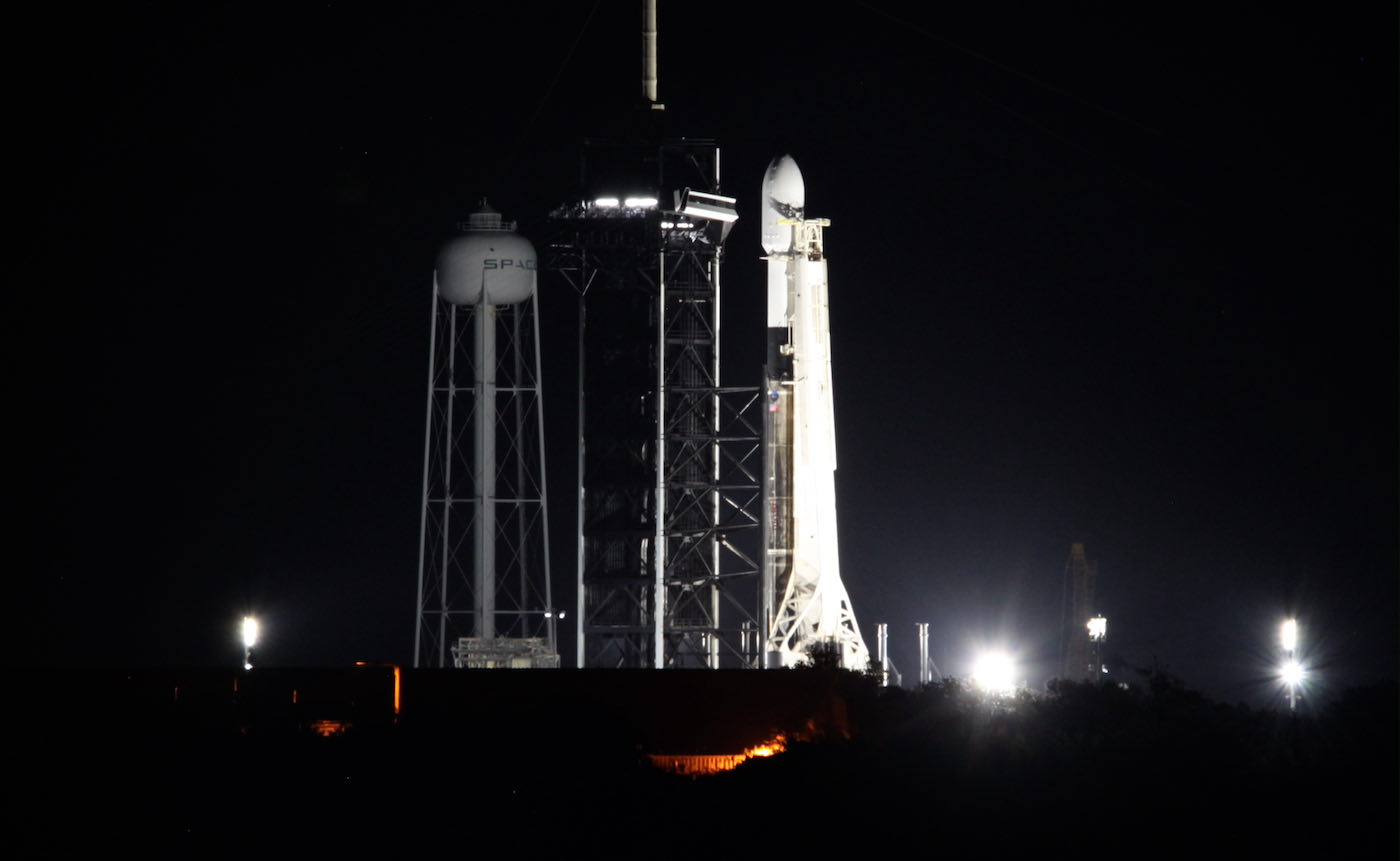Space News & Blog Articles
Live coverage: SpaceX counting down to predawn Starlink launch
Live coverage of the countdown and launch of a SpaceX Falcon 9 rocket from Launch Complex 39A at NASA’s Kennedy Space Center in Florida. The Starlink 4-17 mission will launch SpaceX’s next batch of 53 Starlink broadband satellites. Follow us on Twitter.
SFN Live
SpaceX is poised to launch another batch of 53 Starlink internet satellites at 5:42 a.m. EDT (0942 GMT) Friday from the Kennedy Space Center. There’s a greater than 90% chance of good weather for the predawn blastoff.
The first stage booster — tail number B1058 — will attempt a landing on the drone ship “A Shortfall of Gravitas” positioned roughly due east of Charleston, South Carolina, about eight-and-a-half minutes after launch.
SpaceX teams at Cape Canaveral rolled the Falcon 9 rocket from its hangar to pad 39A and raised it vertical Thursday. Beginning at T-minus 35 minutes, the launch team will oversee loading of kerosene and liquid oxygen propellants into the Falcon 9 through an automated, computer-controlled sequencer.
Helium pressurant will also flowed into the rocket. In the final seven minutes of the countdown, the Falcon 9’s Merlin main engines will be thermally conditioned for flight through a procedure known as “chilldown.” The Falcon 9’s guidance and range safety systems will also be configured for launch at 5:42 a.m.
The 229-foot-tall (70-meter) Falcon 9 rocket will vector its 1.7 million pounds of thrust — produced by nine Merlin engines — to steer northeast over the Atlantic Ocean.
The rocket will surpass the speed of sound in about one minute, then shut down its nine main engines two-and-a-half minutes after liftoff. The booster will detach and fire pulses from cold gas control thrusters, then extend titanium grid fins to help steer the vehicle back into the atmosphere.
Two braking burns will slow down the rocket for landing on the drone ship around 400 miles (650 kilometers) downrange.
This booster — tail number B1058 — will launch on its 12th mission, becoming the third stage in SpaceX’s inventory to reach that milestone. The booster debuted in May 2020 with the launch of the first test flight of SpaceX’s Dragon spacecraft to carry astronauts.
The landing will occur just prior to shutdown of the upper stage engine. The rocket will coast halfway around the world before reigniting the Merlin-Vacuum upper stage engine about 45 minutes into the mission, paving the way for separation of the 53 Starlink satellites at T+plus 54 minutes, 30 seconds.
 A Falcon 9 rocket stands on pad 39A before the Starlink 4-17 mission. Credit: Stephen Clark / Spaceflight Now
A Falcon 9 rocket stands on pad 39A before the Starlink 4-17 mission. Credit: Stephen Clark / Spaceflight Now
Retention rods holding the satellites into a flat-packed configuration on the rocket will jettison, allowing the Starlink platforms to fly away from the second stage. They will unfurl solar arrays and run through automated activation steps, then use krypton-fueled ion engines to maneuver into their operational orbit.
The Falcon 9 will aim to deploy the satellites in a near-circular orbit ranging in altitude between 189 miles and 197 miles (304 by 317 kilometers), at an orbital inclination of 53.2 degrees to the equator. The satellites will use on-board propulsion to do the rest of the work to reach a circular orbit 335 miles (540 kilometers) above Earth.
The Starlink satellites on Friday’s mission will fly in one of five orbital “shells” used in SpaceX’s global internet network. After reaching their operational orbit, the satellites will enter commercial service and begin beaming broadband signals to consumers, who can purchase Starlink service and connect to the network with a SpaceX-supplied ground terminal.
After Friday’s mission, SpaceX will have launched 2,494 Starlink satellites to date, including spacecraft that were decommissioned or suffered failures. More than 2,100 of those satellites are in orbit and functioning as of this week, according to a list maintained by Jonathan McDowell, an astrophysicist who closely tracks spaceflight activity.
Read our mission preview story for more details.
ROCKET: Falcon 9 (B1058.12)
PAYLOAD: 53 Starlink satelllites (Starlink 4-17)
LAUNCH SITE: LC-39A, Kennedy Space Center, Florida
LAUNCH DATE: May 6, 2022
LAUNCH TIME: 5:42:00 a.m. EDT (0942:00 GMT)
WEATHER FORECAST: 90% chance of acceptable weather; Moderate risk of upper level winds; Low risk of unfavorable conditions for booster recovery
BOOSTER RECOVERY: “A Shortfall of Gravitas” drone ship east of Charleston, South Carolina
LAUNCH AZIMUTH: Northeast
TARGET ORBIT: 189 miles by 197 miles (304 kilometers by 317 kilometers), 53.2 degrees inclination
LAUNCH TIMELINE:
T+00:00: Liftoff T+01:12: Maximum aerodynamic pressure (Max-Q) T+02:31: First stage main engine cutoff (MECO) T+02:35: Stage separation T+02:41: Second stage engine ignition T+02:48: Fairing jettison T+06:14: First stage entry burn ignition (three engines) T+06:33: First stage entry burn cutoff T+08:04: First stage landing burn ignition (one engine) T+08:26: First stage landing T+08:47: Second stage engine cutoff (SECO 1) T+45:28: Second stage restart T+45:29: Second stage engine cutoff (SECO 2) T+54:30: Starlink satellite separationMISSION STATS:
152nd launch of a Falcon 9 rocket since 2010 160th launch of Falcon rocket family since 2006 12th launch of Falcon 9 booster B1058 133rd Falcon 9 launch from Florida’s Space Coast 142nd launch overall from pad 39A 48th SpaceX launch overall from pad 39A 95th flight of a reused Falcon 9 booster 44th dedicated Falcon 9 launch with Starlink satellites 18th Falcon 9 launch of 2022 18th launch by SpaceX in 2022 18th orbital launch based out of Cape Canaveral in 2022This email address is being protected from spambots. You need JavaScript enabled to view it. the author.
Follow Stephen Clark on Twitter: @StephenClark1.
When you subscribe to the SpaceZE News Feed, we will send you an e-mail when there are new updates on the site so you wouldn't miss them.

